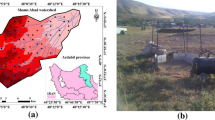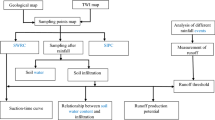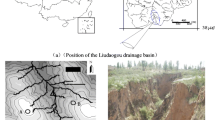Abstract
Purpose
The slope-produced runoff time (runoff time) of colluvium in a benggang (collapse hill and erosion gully) is related to rainfall characteristics and water infiltration as well as slope angle. Additionally, soil water content (SWC) directly correlates with rainfall intensity. This research analyzed the slope-runoff characteristics and the SWC distribution of the colluvium in a benggang catchment by simulated rainfall experiments in situ and the detection of the PR2/6 soil moisture profile probe.
Materials and methods
The simulated rainfall experiments were conducted at Liantanggang benggang in Wuhua county, Guangdong province of southern China. Four old and three new colluvial slopes were selected as the study cases, and the characteristics of their slope runoff and their SWC distribution were investigated using 28 simulated rainfall experiments.
Results and discussion
A negative power function existed between runoff time and rainfall intensity. Moreover, a negative logarithmic function existed between runoff time and initial SWC at a 10-cm depth in the old colluvium. A 3D model was established to predict the runoff time using rainfall intensity and initial SWC. When the rainfall intensity was ≥3.5 mm min−1, the runoff time exhibited a linear negative correlation with the slope angle. The simulated rainfall caused variations in profile SWC. At the 10-cm depth, the old colluvium had an SWC over 20%, whereas the SWC of the new colluvium was below 20%. After 24 h passed, the infiltrated water was redistributed and deeper wetting front depths were observed in the new colluvium than in the old colluvium.
Conclusions
The results demonstrate that the ‘rainfall intensity-initial SWC-runoff time’ model for the colluvial slopes of benggang catchments could be used to predict runoff time based on rainfall intensity and initial SWC. The wetting front depth of the profile SWC could imply that the unstable depth of the colluvium may be beyond the maximum depth of 100 cm.








Similar content being viewed by others
References
Abrol V, Ben-Hur M, Verheijen FGA, Keizer JJ, Martins MAS, Tenaw H, Tchehansky H, Graber ER (2016) Biochar effects on soil water infiltration and erosion under seal formation conditions: rainfall simulation experiment. J Soils Sediments 16:2709–2719
Aksoy H, Erdem Unal N, Cokgor S, Gedikli A, Yoon J, Koca K, Boran Inci S, Eris E (2012) A rainfall simulator for laboratory-scale assessment of rainfall-runoff-sediment transport processes over a two-dimensional flume. Catena 98:63–72
Arnone E, Noto LV, Lepore C, Bras RL (2011) Physically-based and distributed approach to analyze rainfall-triggered landslides at watershed scale. Geomorphology 133:121–131
Bouma NA, Imeson AC (2000) Investigation of relationships between measured field indicators and erosion processes on badland surfaces at Petrer, Spain. Catena 40:147–171
Cao LX, Liang Y, Wang Y, Lu HZ (2015) Runoff and soil loss from Pinus massoniana forest in southern China after simulated rainfall. Catena 129:1–8
Cerdà A, García-Fayos P (1997) The influence of slope angle on sediment, water and seed losses on badland landscapes. Geomorphology 18:77–90
Delta-T Devices Ltd (2015) User Manual for the Profile Probe Type PR2. PR2-UM-4.0
El Kateb H, Zhang HF, Zhang PC, Mosandl R (2013) Soil erosion and surface runoff on different vegetation covers and slope angles: a field experiment in southern Shaanxi Province, China. Catena 105:1–10
Govers G (1992) Relationship between discharge, velocity and flow area for rills eroding loose, non-layered materials. Earth Surf Process Landf 17:515–528
Hao YF, Yang Y, Liu BY, Liu YN, Gao XF, Guo QK (2016) Size characteristics of sediments eroded from three soils in China under natural rainfall. J Soils Sediments 16:2153–2165
Huang CC, Ju YJ, Hwu LK, Lee JL (2009) Internal soil moisture and piezometric responses to rainfall-induced shallow slope failures. J Hydrol 370:39–51
Huang J, Wu PT, Zhao XN (2013) Effects of rainfall intensity, underlying surface and slope angle on soil infiltration under simulated rainfall experiments. Catena 104:93–102
Jiang FS, Huang YH, Wang MK, Lin JS, Zhao G, Ge HL (2014) Effects of rainfall intensity and slope angle on steep colluvial deposit erosion in southeast China. Soil Sci Soc am J 78:1741–1752
Li XZ, Huang YH, Lin JS, Jiang FS, Hao FX, Guan JC, Xu HJ, Yang DD, Wang ZH (2016) Effects of different width of scouring flumes on runoff and sediment yield of colluviums of collapsing hill. Trans Chin Soc Agric Eng 32(9):136–141 in Chinese, with English abstract
Liang Y, Ning DH, Pan XZ, Li DC, Zhang B (2009) Benggang erosion feature and control in southern red zone. Soil Water Conserv China. (1):31–34 (in Chinese, with English Abstract)
Lin JS, Huang YH, Wang MK, Jiang FS, Zhang XB, Ge HL (2015) Assessing the sources of sediment transported in gully systems using a fingerprinting approach: an example from south-east China. Catena 129:9–17
Liu XL, Zhang DL (2015) Temporal-spatial analyses of collapsed gully erosion based on three-dimensional laser scanning. Trans Chin Soc Agric Eng 31(4):204–211 in Chinese, with English abstract
Liu DD, She DL, Yu SE, Shao GC, Chen D (2015) Rainfall intensity and slope angle effects on sediment losses and splash from a saline-sodic soil under coastal reclamation. Catena 128:54–62
Luffman IE, Nandi A, Spiegel T (2015) Gully morphology, hillslope erosion, and precipitation characteristics in the Appalachian valley and ridge province, southeastern USA. Catena 133:221–232
Luk SH, diCenzo PD, Liu XZ (1997) Water and sediment yield from a small catchment in the hilly granitic region, south China. Catena 29:177–189
Mahmoodabadi M, Arjmand SS (2016) Effects of rain intensity, slope angle and particle size distribution on the relative contributions of splash and wash loads to rain-induced erosion. Geomorphology 253:159–167
Martínez-Murillo JF, Nadal-Romero E, Regüés D, Cerdà A, Poesen J (2013) Soil erosion and hydrology of the western Mediterranean badlands throughout rainfall simulation experiments: a review. Catena 106:101–112
Mathys N, Klotz S, Esteves M, Descroix L, Lapetite JM (2005) Runoff and erosion in the black marls of the French alps: observations and measurements at the plot scale. Catena 63:261–281
Medeiros PHA, de Araújo JC (2014) Temporal variability of rainfall in a semiarid environment in Brazil and its effect on sediment transport processes. J Soils Sediments 14:1216–1223
Ni HY (2015) Experimental study on initiation of gully-type debris flow based on simulated rainfall and channel runoff. Environ Earth Sci 73:6213–6227
Rahardjo H, Lee TT, Leong EC, Rezaur RB (2005) Response of a residual soil slope to rainfall. Can Geotech J 42:340–351
Sirvent J, Desir G, Gutierrez M, Sancho C, Benito G (1997) Erosion rates in badland areas recorded by collectors, erosion pins and profilometer techniques (Ebro Basin, NE-Spain). Geomorphology 18:61–75
Solé-Benet A, Calvo A, Cerdà A, Lazaro R, Pini R, Barbero J (1997) Influences of micro-relief patterns and plant cover on runoff related processes in badlands from Tabernas (SE Spain). Catena 31:23–38
Van Dijk AIJM, Bruijnzeel LA, Eisma EH (2003) A methodology to study rain splash and wash processes under natural rainfall. Hydrol Process 17:153–167
Xu JX (1996) Benggang erosion: the influencing factors. Catena 27:249–263
Zhang DL, Liu XL (2015) Permeability and sectional moisture characteristics of deposits in collapse hill: an example of Liantanggang collapse hill in Wuhua County of Guangdong Province. Bull Soil Water Conserv 35(2):251–262 in Chinese, with English abstract
Zhang XM, Ding SW, Cai CF (2012) Effects of drying and wetting on nonlinear decay of soil shear strength in slope disintegration erosion area. Trans Chin Soc Agric Eng 28:241–245 in Chinese, with English abstract
Zhong MY, Li FM (2010) Statistical analysis of the precipitation during recent 52 years and the estimation of recurrence period for the maximum precipitation in Wuhua County. Guangdong Water Res Hydropower 12:37–40 in Chinese, with English abstract
Acknowledgements
This research was funded by the National Natural Science Foundation of China (Grant No. 41071186). The authors thank Zhihai Shang, Yaoyao Jia, Qinqing Huang, Jia Wang, Hongting Zhao, Bo Tang, Chunshan Tian, and Haiqing Lian, who participated in the fieldwork. The reviewers, editor, and Dr. Tanesha Allen are appreciated for their contributions to improve the manuscript and the English usage.
Author information
Authors and Affiliations
Corresponding author
Additional information
Responsible editor: Gilbert Sigua
Rights and permissions
About this article
Cite this article
Liu, X., Qiu, J. & Zhang, D. Characteristics of slope runoff and soil water content in benggang colluvium under simulated rainfall. J Soils Sediments 18, 39–48 (2018). https://doi.org/10.1007/s11368-017-1742-0
Received:
Accepted:
Published:
Issue Date:
DOI: https://doi.org/10.1007/s11368-017-1742-0




